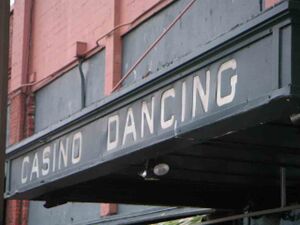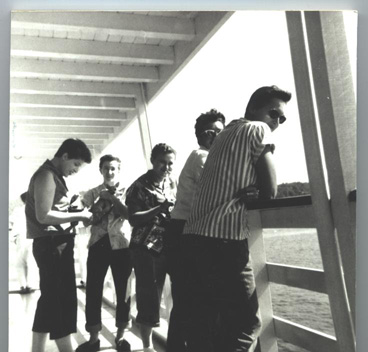1950s - Pioneer Square
1950s - Pioneer Square
At the turn of the 19th century, Pioneer Square was the heart of Seattle’s downtown, but as the city grew, the downtown core drifted north and over time, Pioneer Square became a less desirable place. By the 1930s, the term “Skid Row” was part of the national vocabulary, replacing the original reference to Henry Yesler’s “Skid Road” for the lumber mill. As this happened, the area also became identified for providing services for people on the edges of Seattle society. The gay community was a part of the wave of individuals who wound up calling Pioneer Square home, and until the 1970s Pioneer Square was the heart of gay and lesbian Seattle.
This birthplace of Seattle's gay community was the location for many of the earliest gay bars, bathhouses, and other spaces. Though men made up most of the clientele, some bars catered especially to women, including the Silver Slipper, the Submarine Room, and the Madison Tavern. While strict Blue Laws governed all the city's bars, both gay and straight, these laws were often used selectively by police to harass gay bars and to demand payoffs. In 1958, MacIver Wells, owner of the Madison, sought and was granted a court injunction against police harassing his customers. Partly because of this injunction, women were able to dance together at the Madison.
To hear an interview about Seattle’s early gay history on KUOW.org, Puget Sound Public Radio [1].
The Garden of Allah, Seattle's first gay-owned gay bar, was located in the basement of the Arlington Hotel at Post and Seneca from 1946 to 1956. Entertainment at the Garden included vaudeville, burlesque, and variety shows with female impersonators as its main attraction. The Garden's shows attracted men and women, gay and straight, and often featured nationally recognized performers. Characterized as wild and bawdy, the Garden was like home to many of its patrons, fostering a sense of community and family among gays and lesbians in Seattle.
Under this marquee, was a gay and lesbian gathering spot in the 1930s through 1950s— first as an after-hours club (also pool hall and card room) named the Casino and later known as Madame Peabody’s Dancing Academy for Young Ladies…or simply…“The Dance.” The Dance was one of the few places on the West Coast where same-sex dancing was allowed; in fact, it was known up and down the coast for this very fact. Through an “underground railroad” of sorts, information about the nightlife and hot spots in cities was passed from Vancouver, BC to Los Angeles, CA.
The following is excerpted from an affidavit of a 1965 case challenging Washington’s sodomy law, which described a scene at the Casino.
- Witness: “Men dressed in elaborate wigs and gowns mincing down the street in ill-fitting women’s shoes and women with mannish haircuts, slacks and jackets. Inside there were approximately five to seven hundreds gyrating humans. It was obvious that the gyrations were not being done in tune with the music, but from the sexual urge of the performers. They kissed everyone they met and hugged and embraced each other with complete abandon.”
Located on the street level of the same building as the Casino. The bar still known as the Double Header advertises itself as the oldest continually operating gay bar on the West Coast. It opened in 1934 after the ending of Prohibition, and although it has never been gay-owned, it has always been gay friendly.
Prohibition began in 1916 in Seattle and lead to a system of “protection” that allowed the bars to flourish. The system of payoffs to police officers was in place until the late 1960s when through the efforts of another tavern owner in cooperation with the FBI it was eliminated.
As Seattle’s population exploded during the 1940s - 1960s, the Double Header was one of the more popular venues in town, known for drag shows and an all-female oompah band called the Cracker Barrels. During the World’s Fair in 1962, the Double Header, as well as a lot of other taverns, was a popular location. This bar still maintains its reverence for history, evident in the many photos and memorabilia displayed on the walls.
At the turn-of-the-century Seattle when Pioneer Square was still the heart of downtown and the height of fashion, one of the big attractions to this area was the Northern Hotel and its fabulous spa. The Northern Hotel was built in 1889 by Seattle founders Charles Terry and Arthur Denny. As Pioneer Square became a district of flophouses and working-class apartments, however, the spa became the Turkish Steam Baths, and by the middle of World War II, it became the South End.
While not the only gay bathhouse in Seattle, the South End was certainly the oldest. Although baths are often thought of as a purely sexual space, they were also an important social space for gay men. Many of the baths were exclusively gay and were often less prone to police raids than the bars, so they tended to be one of the safest public spaces available to gay men at this time. In his book Gay New York, George Chauncey has shown that the “cruising grounds” of gay men—baths, parks and so on—were almost part of an “invisible city” hidden from, yet right under the noses of, the straight world.
In addition to the bars and baths, GLBT people have always had private space. Many informal social networks existed, especially in urban areas. These are much harder to document, because the only records of them reside in personal snapshot collections. We know, however, that such networks existed in Seattle and Vancouver, and even in rural King County. From time to time, such private groups would rent out community centers and Grange halls for large social dances and parties.
In the majority of the bars and tavern, the clientele was a combination of gay men and lesbian women, with men in the majority. For the decades in which Pioneer Square was the center of the “organized” gay community in Seattle, it is important to remember the difference in the social status of women. For an unescorted woman to be in Pioneer Square in the 1950s, even among female peers, was a risky act. Consider for a moment the “ideal woman” of the 1950s and 1960s, and you’ll be able to sense the boundaries women were crossing simply by participating in the gay world of Pioneer Square.
Seattle, WA: Queen City Comes Out: Exploring Seattle's Lesbian and Gay History

